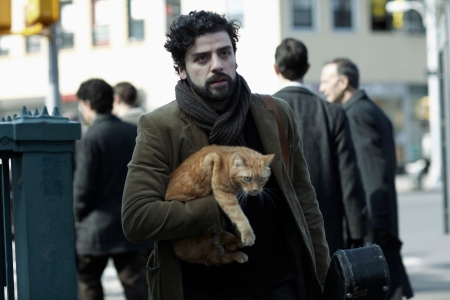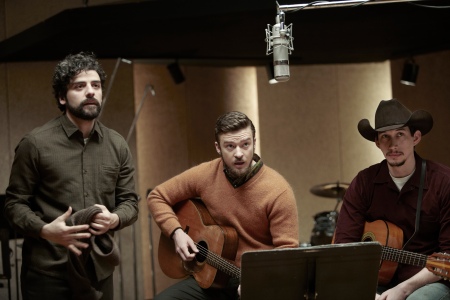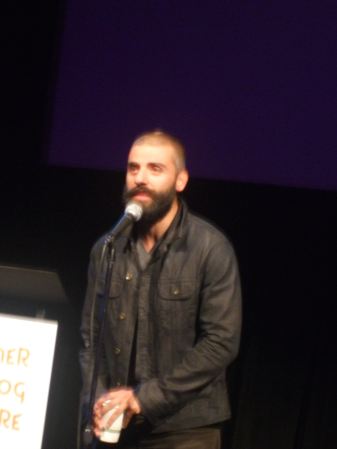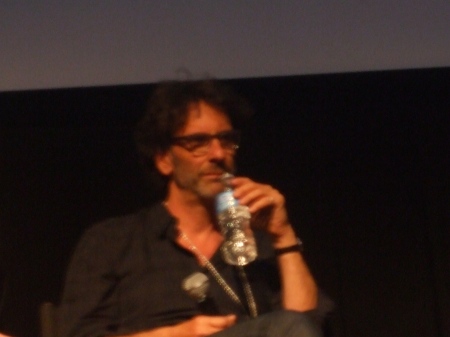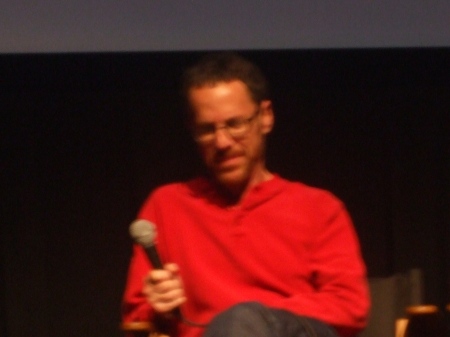One of the highlights of this year’s Telluride Film Festival was a Tribute to the Coen Brothers and their musical producer T Boone Burnett. Brothers Joel and Ethan Coen jointly write, direct, and produce their films. Their latest film “Inside Llewyn Davis”, the Coen’s best since “Barton Fink”(1991), and possibly their finest, was also shown. This film received the runner-up Grand Prix at Cannes.
“Inside Llewyn Davis” begins in 1961 with folksinger Llewyn Davis (Oscar Isaac, “Drive”, “Robin Hood”) being beaten up outside the Gaslight Café in Greenwich Village. Flashbacks lead up to the incidents behind Llewyn’s latest painful experience. The film is set before the success of Bob Dylan. The dull winter colors In the images from cinematographer Bruno Delbonnel bring a somber edge to the proceedings.
Llewyn Davis is one of the Coens’ most fascinating and complex characters. Llewyn had been part of a folk singing duo. He continues to be affected by his partner’s death. Not a success, Llewyn sleeps on the couches or extra beds of his acquaintances.
When leaving the empty apartment of a friend, the host’s cat follows Llewyn. Without a key and since the doorman refuses to take care of the cat until the owner’s return, he carries the cat to his next stop, the apartment of a musician friend. Llewyn humorously tries to control the cat while on the subway and afterward. As usual with their film, the Coens have provided memorable faces among the people Llewyn encounters. He stops at the apartment of his friend Jim (Justin Timberlake) and Jim’s disdainful wife Jean (Carey Mulligan), fellow folksingers. Llewyn occasionally joins Jim and others in song.
Though Llewyn is talented, success has eluded him for a variety of reasons. He does not want to compromise and is derisive of anyone he believes sells out for popularity. He is also self-destructive, making bad choices and taking advantage of people who continually help him. He must also, like other Coen characters, deal with fate – an escaped cat, the consequences of a fling with Jean, and more. Llewyn takes a car ride to Chicago along with a scornful man played by John Goodman in another fine Coen characterization.
“I don’t see a lot of money here” a character in the music business tells Llewyn.
Oscar Isaac gives a terrific lead performance. An accomplished singer, he brings out the conflicted sides and intensity of Llewyn’s personality. His face often has a weighted-down look.
The Coens’ trademark twisted humor and the unexpected turns to Llewyn’s journeys make their film intriguing and continually absorbing. There is an atmospheric recreation of Greenwich Village of the early 1960s and striking wintry images.
At their Telluride Tribute with their music producer, the Coen Brothers discussed the importance of music in their films. They spoke amusingly about making super 8 films together as kids, like a remake of the jungle-set “The Naked Prey”. A super 8 version of the politically-themed “Advise and Consent” was also considered.
On the theme of their current film, Joel said they listened to Allan Sherman’s song “My Son the Folksinger” as well as other folk music when young.
Their “The Big Lebowski”, had a diverse selection of music. Ethan said that since the music producer T Boone Burnett chose a song by Peruvian soprano Yma Sumac, the trampoline scene was set at an Inca beach party. Burnett said the music choices were important in setting the tone of that film.
The Coen’s films often start with imagining a single image. “O Brother Where Art Thou?” began, according to Ethan, with “three dopes chained together”. They set the script aside for eight years. Regarding the delay, Joel said “Let’s say we’re adapting the Odyssey” and the film became a loose modern revision.
Regarding “Inside Llewyn Davis”, Ethan said that “a success story wouldn’t appeal to us.” Joel added that the brothers knew about the folk music scene before Bob Dylan became its “transformative character” from the memoir of folksinger Dave Van Ronk, “The Mayor of MacDougal Street”.
Joel described Dylan as the “elephant in the room” and said they had a “fascination” with “what did he walk into?” Ethan added they wanted the central character someone who was “never going to be Bob Dylan.”
For the singing scenes Burnett said they “wanted to do it live”, a “dangerous way to shoot film.” He described the story as “every musician’s life”.
Ethan said the film was cut “more like documentary.”
Joel described star Oscar Isaac as a “real musician”, “rare” for an actor. He added that he didn’t believe they would have made “Inside Llewyn Davis” without him.
Of one of Isaac’s main costars, Joel joked that he hadn’t learned the lesson of “not working with a cat” since “you can’t train, can’t ask a cat to do anything.”
